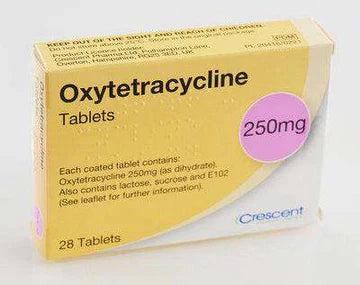Oxytetracycline


Oxytetracycline is an oral antibiotic treatment for acne, rosacea and other bacterial infections. This medication is suitable for treating persistent and cystic acne as well as many common bacterial infections.
What is Oxytetracycline?
Oxytetracycline is a prescription antibiotic medication that can treat various bacterial infections, including lung infections, UTIs, STIs, skin infections and infections of the eye such as conjunctivitis.
How does it work?
Oxytetracycline is a broad-spectrum tetracycline antibiotic. Antibiotics work by killing off bacteria or preventing them from spreading. Tetracycline antibiotics are largely used to treat acne and rosacea.
Is Oxytetracycline suitable for me?
This medication is not suitable for those under 12 years of age. Consult with your doctor before beginning this medication.
The product images shown may represent the range of products, or be for illustration purposes only and may not be an exact representation of the product.
Commonly Used Dosage Guidelines for Oxytetracycline.
The usual doses are for at least 10 days unless otherwise directed by your doctor. For Adults, Elderly and Children 12 years or over.
For general infections:
For Specific infections:
All medications can cause potential side effects, below we have listed some potential side effects, however, these do not always occur. If you notice these or indeed any unexpected reactions you should tell your doctor or pharmacist.
To read the Oxytetracycline Patient Leaflet, click here.
The information provided in this blog post is intended for general informational purposes only and should not be considered as medical advice, diagnosis, or treatment. Welzo does not endorse or sell the medication discussed, nor do we recommend using this information as a substitute for professional healthcare. Always consult with a qualified healthcare provider before making any decisions regarding your health or medical treatment. Welzo assumes no responsibility for any actions taken based on the information provided in this blog.










Plus get the inside scoop on our latest content and updates in our monthly newsletter.